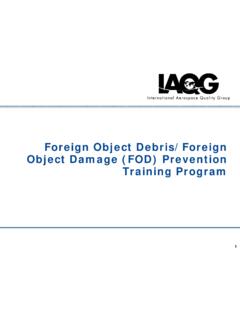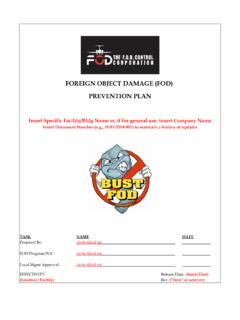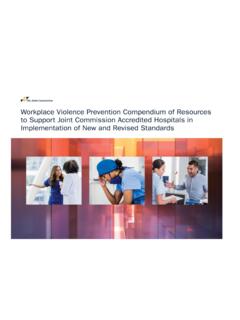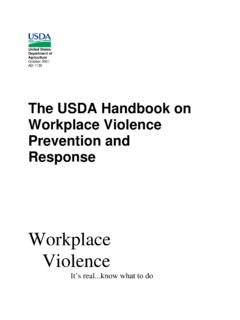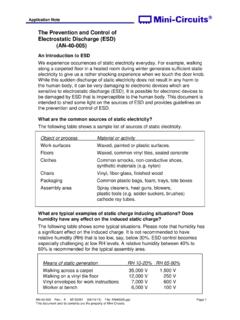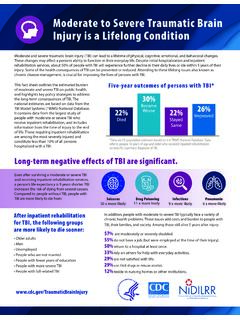Transcription of Pressure Ulcers Among Nursing Home Residents: United ...
1 NCHS Data Brief No. 14 February department of health and human servicescenters for disease control and preventionnational center for health statisticsPressure Ulcers Among Nursing Home Residents: United States, 2004eunice park-lee, , and christine caffrey, , division of health care statisticsKey findingsdata from the national Nursing home survey, 2004In 2004, about 159,000 current Nursing home residents (11%) had Pressure Ulcers . Stage 2 Pressure Ulcers were the most common. Residents aged 64 years and under were more likely than older residents to have Pressure of Nursing homes for a year or less were more likely to have Pressure Ulcers than those with longer stays. One in five Nursing home residents with a recent weight loss had Pressure Ulcers . Thirty-five percent of Nursing home residents with stage 2 or higher (more severe) Pressure Ulcers received special wound care services in Ulcers , also known as bed sores, Pressure sores, or decubitus Ulcers , are wounds caused by unrelieved Pressure on the skin (1).
2 They usually develop over bony prominences, such as the elbow, heel, hip, shoulder, back, and back of the head (1 3). Pressure Ulcers are serious medical conditions and one of the important measures of the quality of clinical care in Nursing homes (1,4). From about 2% to 28% of Nursing home residents have Pressure Ulcers (2,3). The most common system for staging Pressure Ulcers classifies them based on the depth of soft tissue damage, ranging from the least severe (stage 1) to the most severe (stage 4). There is persistent redness of skin in stage 1; a loss of partial thickness of skin appearing as an abrasion, blister, or shallow crater in stage 2; a loss of full thickness of skin, presented as a deep crater in stage 3; and a loss of full thickness of skin exposing muscle or bone in stage 4. Clinical practice guidelines for Pressure Ulcers have been developed and provide specific treatment recommendations for stage 2 or higher Pressure Ulcers , including proper wound care (5).
3 This Data Brief presents the most recent national estimates of Pressure ulcer prevalence, resident characteristics associated with Pressure Ulcers , and the use of wound care services in Nursing homes. Keywords: Pressure Ulcers wound care Nursing home residents quality of care More than 1 in 10 Nursing home residents had a Pressure ulcer. figure 1. percentage of Nursing home residents with Pressure Ulcers : United states, 200411024681012 Any Pressure ulcers3 Stage 15 Stage 21 Stage 32 Stage 4 Percentsource: cdc/nchs, national Nursing home Data Brief No. 14 February 2009 2 Of the million current Nursing home residents in 2004, about 159,000 (11%) had Pressure Ulcers of any stage. Stage 2 was the most common (5%), accounting for about 50% of all Pressure Ulcers . Stages 1, 3, and 4 made up about the other 50% of all ulcer prevalence varied by age, sex, and length of time since admission to the Nursing home, but not by race.
4 Residents aged 64 years and under were more likely than older residents to have Pressure Ulcers (14% and 10%, respectively). Pressure Ulcers were more common in males (13%) than in females (10%). Residents in Nursing homes for 1 year or less (16%) were more likely to have Pressure Ulcers than those with a longer length of stay (7%). There was no significant difference between white and nonwhite populations with respect to having Pressure Ulcers . figure 2. percentage of Nursing home residents with Pressure Ulcers , by selected demographics: United states, 200411163714210131101111024681012141618 All Nursing home residentsOne-year stay or lessMore than 1 year stay64 years and underOlder than 64 yearsMaleFemaleWhiteNonwhitePercent Significantly different from female Nursing home residents. Significantly different from Nursing home residents who were older than 64 years.
5 Significantly different from Nursing home residents who had stayed in the facility more than 1 year. source: cdc/nchs, national Nursing home Data Brief No. 14 February 2009 3 Pressure ulcer prevalence varied by different resident clinical characteristics. Among Nursing home residents, those with a recent weight loss (20%) were more likely to have Pressure Ulcers than those who had not had a recent weight loss (10%). Nursing home residents who had high immobility (16%) had an 11% greater occurrence of Pressure Ulcers than those without high immobility (5%). Polypharmacy, or taking more than eight medications, was related to a greater prevalence of Pressure Ulcers (13% and 9%, respectively). Pressure Ulcers were more prevalent (12%) Among residents who had any recent bowel or bladder incontinence than Among continent residents (7%).
6 Figure 3. percentage of Nursing home residents with Pressure Ulcers , by selected resident clinical characteristics: United states, 200411204101635132912170510152025 All Nursing home residentsRecent weight lossNo recent weight lossHigh immobilityNo high immobilityMore than eight medicationsEight or fewer medicationsRecent incontinenceNo recent incontinencePercent1 Significantly different from residents who had no recent incontinence. 2 Significantly different from residents who took eight or fewer Significantly different from residents who had no high immobility. 4 Significantly different from residents who had no recent weight loss. source: cdc/nchs, national Nursing home Data Brief No. 14 February 2009 4 Thirty-five percent of Nursing home residents with stage 2 or higher Pressure Ulcers received special wound residents with stage 2 or higher Pressure Ulcers , 35% received wound care by specially trained professionals or staff.
7 The percentage receiving special wound care was slightly higher for those with stage 4 (40%) than those with stage 2 (33%) or stage 3 (37%); however, these differences were not statistically significant. figure 4. percentage of Nursing home residents with stage 2 or higher Pressure Ulcers , by status of receiving special wound care: United states, 2004 Percent353337406567636001020304050607080 90100 Stage 2 or higherpressure ulcersStage 2 Stage 3 Stage 4 ReceivedNot receivedsource: cdc/nchs, national Nursing home Data Brief No. 14 February 2009 5 SummaryOverall, 11% of Nursing home residents had Pressure Ulcers in 2004. Various demographic and clinical factors were related to having a Pressure ulcer in a Nursing home. Residents in a Nursing home for a year or less since admission, who had a recent weight loss, or who had high immobility had the highest prevalence of Pressure Ulcers .
8 Among residents with a Pressure ulcer of stage 2 or higher, 35% received special wound care services. This suggests that a minority of Nursing home residents with stage 2 or higher Pressure Ulcers received wound care in accordance with the clinical practice guidelines. Pressure Ulcers are serious and common medical conditions in Nursing homes, and remain an important public health problem. Information from this Data Brief on Pressure ulcer prevalence and service use Among Nursing home residents with Pressure Ulcers may provide a foundation for targeting public health Ulcers : Nursing home providers were asked the highest stage of any Pressure ulcer the sampled resident currently had. This measure had five categories: no Pressure ulcer, stage 1, stage 2, stage 3, and stage 4. Stage 1: A persistent area of skin redness (without a break in the skin) that does not disappear when Pressure is relieved.
9 Stage 2: A partial thickness is lost and may appear as an abrasion, blister, or shallow crater. Stage 3: A full thickness of skin is lost, exposing the subcutaneous tissues presents as a deep crater with or without undermining adjacent tissue. Stage 4: A full thickness of skin and subcutaneous tissues are lost, exposing muscle or bone. Recent Weight Loss: It is defined by a yes response to the following question: Has the sampled Nursing home resident had weight loss of 5% or more during the past 30 days or 10% or more during the past 180 days? High Immobility: It is measured using two measures, bed mobility (how resident moves to and from lying position, turns side to side, and positions body while in bed) and transfer (how resident moves between surfaces to and from: bed, chair, wheelchair, and standing position). Each measure had five response categories: independent, supervision, limited assistance, extensive assistance, and total dependence.
10 Residents were considered to have high immobility if they had a response of extensive assistance or total dependence for either or both bed mobility and transfer. Recent Incontinence: It is measured using five categories: continent, usually continent (incontinent episodes less than weekly), occasionally incontinent (incontinent episodes once a week), frequently incontinent (incontinent 2 to 3 times a week), and total dependence (incontinent all or almost all of the time) in the last 14 days. Residents were considered to have incontinence if they were at least usually incontinent of the bladder or Data Brief No. 14 February 2009 6 Special Wound Care Services: It is defined by a yes response to the following question: Is the sampled Nursing home resident currently receiving services from a special program for skin or wound conditions?










